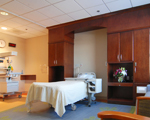The new 2010 FGI Guidelines for Design and Construction of Health Care Facilities recommend sound reinforcement systems in healthcare environments. As such, we often get the question: how do you save money on audio-visual systems in the health care sector? Well, there are many practical ways to cut cost without cutting quality, and as independent consultants we often work with our clients to understand how to do just that.
Here are a few good ideas that will help with the bottom line:
- Thorough pre-programming. An essential part of the design process is having the stakeholders of a particular space spend some “quality time” defining the requirements of the room. Answer the question, “What events will be go on in the space and what types of technologies will be needed to support them?” Also, assess the technical capabilities of the end-users. More complex systems may require a more simplified control interface!
- Define the required technologies. Is high-definition video needed in the room? Will video conferencing need to happen here? Is the space large enough to require microphones and speakers? These types of question help to establish what technologies will be needed.
- Hire a good consultant to document the design. Once you have a solid list of the events in the space and the technologies that will be needed to support them, get with a great consultant who can help to document the design. A well-designed project that is bid competitively will almost always be less expensive than a design/build project.
- Bid the project to a limited number of qualified contractors. Today’s bidding environment is very competitive-which is a good thing for owners and end-users. The temptation is to have as many contractors bid on the project as possible. However, this can have the effect of receiving lower quality bids. Good contractors who have work (which most good contractors do!) won’t low-ball a bid and know that they can’t be successful if they are doing work with too little margin. By limiting the bid field and pre-qualifying the best contractors, it is possible to get good pricing while also ensuring you get a good contractor.
- Evaluate the long-term usage & replacement. Many times the best way to save money over the long term is to spend a little more money in the short term. Lower quality equipment will tend to have a shorter life span and the replacement and repair costs can quickly become much more expensive than if you had paid more for a higher quality piece. Higher quality equipment also tends to have more flexible inputs and technology which may allow it to adapt to changing needs in future years.
Taking the time to figure out what needs to happen in your space while also taking the right steps through the design and bidding process can help to make sure that your project will be successful and cost-effective. At Acoustics By Design we’re experts at determining where to cut cost in audio-visual systems design and where spending the money just makes sense.
